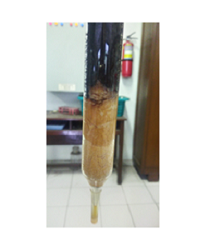
Determination of cation exchange capacity and analysis of cation availability in hemic and sapric peat with different preparation and extraction methods
Mirna Anriani Siregar(1), Azwar Ma'as(2*), Makruf Nurudin(3)
(1) Department of Soil Science, Faculty of Agriculture, Universitas Gadjah Mada, Jln. Flora no.1, Bulaksumur, Sleman, Yogyakarta 55281
(2) Department of Soil Science, Faculty of Agriculture, Universitas Gadjah Mada, Jln. Flora no.1, Bulaksumur, Sleman, Yogyakarta 55281
(3) Department of Soil Science, Faculty of Agriculture, Universitas Gadjah Mada, Jln. Flora no.1, Bulaksumur, Sleman, Yogyakarta 55281
(*) Corresponding Author
Abstract
Keywords
Full Text:
PDFReferences
Boelter, D. H. (1969). Physical properties of peats as related to degree of decomposition. Soil Science of America Proceedings, 33, pp. 606-609.
Balai Penelitian Tanah. (2009). Petunjuk teknis analisis kimia tanah, tanaman, air, dan pupuk. 2nd ed. Bogor: Balai Penelitian Tanah, pp. 200
Charman, D.J. (2009). Peat and peatlands. In: Likens, G.E. ed. Encyclopedia of Inland Waters. Amsterdam: Elsevier, pp. 541-548.
Dewis, J. and Freitas, F. (1970). Physical and chemical methods of soil and water analysis. 10th ed. Rome: Food and Agriculture Organization, pp. 275
Hikmatullah, Nugroho, K., and Sarwani, M. (2014). Characterizing the cultivated lowland peat soils in two physiography positions in Kalimantan, Indonesia. International Research Journal of Agricultural Science and Soil Science, 3(7), pp. 246-255
Indrawati, U.S.Y.V., Maas, A., Utami, S.N.H., and Hanudin, E. (2018). Characteristic of three biochar types with different pyrolysis time as ameliorant of peat soil. Indian Journal of Agricultural Research, 51(5), pp. 458-462.
Lampela, M., Jauhiainen, J., and Vasander, H. (2014). Surface peat structure and chemistry in a tropical peat swamp forest. Plant and Soil, 382(1-2), pp. 329-347.
Ma'as, A. 2010. Interpretasi gambut untuk budidaya. [online]. Available at: http://balittra.litbang.pertanian.go.id/index.php/berita/info-aktual/108-interpretasi-gambut-untuk-budidaya-pertanian. [Accessed 17 December 2020].
Maftuah, Fahmi, A., and Hayati, A. (2019). Changes in degraded peat land characteristic using FTIR-spectrocopy. IOP Conference Series: Earth and Environment Science, 393, pp. 012091
Masganti. (2012). Sample preparation for peat material analysis. Prosiding Workshop on Sustainable Management Lowland for Rice Production, pp. 179-184.
McCormick, P.V., Harvey, J.W., and Crawford, E.S. (2011). Influence of changing water sources and mineral chemistry on the everglades ecosystem. Environmental Science and Technology, 41(Sup1), pp. 28-63.
Perdana, L.R., Ratnasari, N.G., Ramadhan, M.L., Palamba, P., Nasruddin, and Nugroho, Y. S. (2018). Hydrophilic and hydrophobic characteristics of dry peat. IOP Conference Series: Earth and Environmental Science, 105, pp. 012083.
Rechcigl, J.E., Payne, G.G., and Sanchez, C.A. (2008). Comparison of various soil drying techniques on extractable nutrients. Communications in Soil Science and Plant Analysis, 23(17-20), pp. 2347-2363.
Sudadi and Parwati. (2013). Pengaruh sifat ketidakbalikon tanah gambyang dihadapkan pada tingkat lengas dan lama inkubasi tertentu terhadap beberapa sifat kimianya. Sains Tanah, 4(1), pp. 17-20.
Szajdak, L. and Szatylowicz, J. (2010). Impact of drainage on hydrophobicity of fen peat-moorsh soils. Mires and Peat, 6, pp. 158-174.
Szajdak, L., Jezierski, A., Wegner, K., Meysner, T., and Szczepanski, M. (2020). Influence of drainage on peat organic matter: Implications for development, stability, and transformation. Molecules, 25(11), pp. 1-27.
Utami, S. N. H., Ma'as, A., Radjagukguk, B., and Purwanto, B. H. (2009a). Restorasi gambut dengan tiga jenis surfaktan, dan pengaruhnya terhadap efesiensi penyimpanan kation dan kapasitas memegang air. Agritech, 29(1), pp. 36-41.
Utami, S. N. H., Ma'as, A., Radjagukguk, B., and Purwanto, B. H. (2009b). Sifat fisik, kimia dan FTIR spektrofotometri gambut hidrofobik Kalimantan Tengah. Jurnal Tanah Tropika, 14(2), pp. 159-166.
Wang, M., Talbot, J., and Moore, T. R. (2018). Drainage and fertilization effects on nutrient availability in an ombrotrophic peatland. Science of the Total Environment, 621, pp. 1255-1263.
Winarna, Murtilaksono, K., Sabihan, S., Sutandi, A., and Sutarta, E. S. (2016). Hydrophobicity of tropical peat soil from an oil palm plantation in North Sumatra. Journal of Agronomy, 15(3), pp. 114-121.
Winarna, (2015). Pengaruh kedalaman muka air tanah dan dosis terak baja terhadap hidrofobisitas tanah gambut, emisi karbon, dan produksi kelapa sawit. Dissertation. Institut Pertanian Bogor.
Wu, Y., Zhang, N., Slater, G., Waddington, J. M., and Lannoy, C. D. (2020). Hydrophobicity of peat soils: Characterization of organic compound changes associated with heat-induced water repellency. Science of the Total Environment, 714, pp. 1-15.
Zabowski, D and Ugolini, F.C. (1990). Lysimeter and soil solutions: seasonal differences between methods. Soil Science Society of America Journal, 54(4), pp. 1130-1135.
Article Metrics
Refbacks
- There are currently no refbacks.
Ilmu Pertanian (Agricultural Science) ISSN 0126-4214 (print), ISSN 2527-7162 (online) is published by Faculty of Agriculture Universitas Gadjah Mada collaboration with Perhimpunan Sarjana Pertanian Indonesia (PISPI) and licensed under a Creative Commons Attribution-ShareAlike 4.0 International License.











_2025_-_kecil_.png)
_2024_kecil_2.png)
